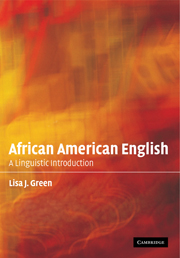Book contents
- Frontmatter
- Contents
- Foreword by John R. Rickford
- Preface
- Introduction
- 1 Lexicons and meaning
- 2 Syntax part 1: verbal markers in AAE
- 3 Syntax part 2: syntactic and morphosyntactic properties in AAE
- 4 Phonology of AAE
- 5 Speech events and rules of interaction in AAE
- 6 AAE in literature
- 7 AAE in the media
- 8 Approaches, attitudes and education
- Endnotes
- References
- Acknowledgments
- Index
5 - Speech events and rules of interaction in AAE
Published online by Cambridge University Press: 05 June 2012
- Frontmatter
- Contents
- Foreword by John R. Rickford
- Preface
- Introduction
- 1 Lexicons and meaning
- 2 Syntax part 1: verbal markers in AAE
- 3 Syntax part 2: syntactic and morphosyntactic properties in AAE
- 4 Phonology of AAE
- 5 Speech events and rules of interaction in AAE
- 6 AAE in literature
- 7 AAE in the media
- 8 Approaches, attitudes and education
- Endnotes
- References
- Acknowledgments
- Index
Summary
Focal point Syntactic and phonological patterns alone cannot sufficiently characterize AAE. Speakers manipulate common strategies of conversational interaction, and they adhere to rules of speaking in using speech events such as call and response in religious as well as secular contexts. Rhetorical strategies may be more prominent than syntactic and phonological features in speech events such as rap and sermons.
Pastor: Then he, then he, then he stops, then he stops, then he stops and he, he thinks about what happens. He says, hunh? “Through many dangers, snares I have already come. It WAS” Congregation: Grace!
[passage from sermon]Introduction
The purpose of chapters 2, 3 and 4 was to explain that syntactic and phonological patterns in AAE are rule-governed, so it is inaccurate to characterize the sentence and sound structures as random deviations from general American English. In presenting the range of descriptions of conditions and constraints that speakers adhere to when they use AAE, I provided examples (from conversation and data collection) that would further illustrate the features of language use. The types of examples that have been provided only reflect a part of the language use. This chapter will discuss additional ways in which language is used in AAE, focusing on speech events and rules of interaction.
- Type
- Chapter
- Information
- African American EnglishA Linguistic Introduction, pp. 134 - 163Publisher: Cambridge University PressPrint publication year: 2002



